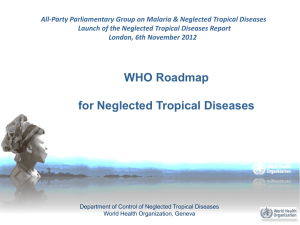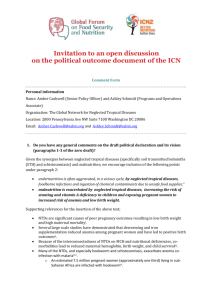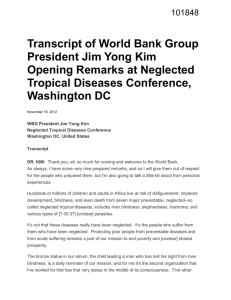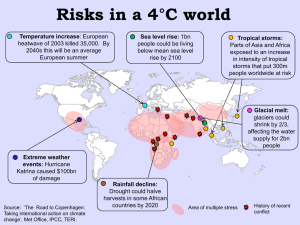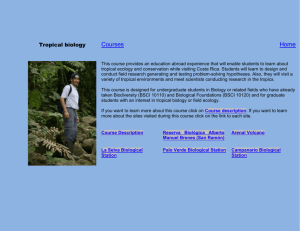Viewpoint Rescuing the bottom billion through control of neglected tropical diseases
advertisement
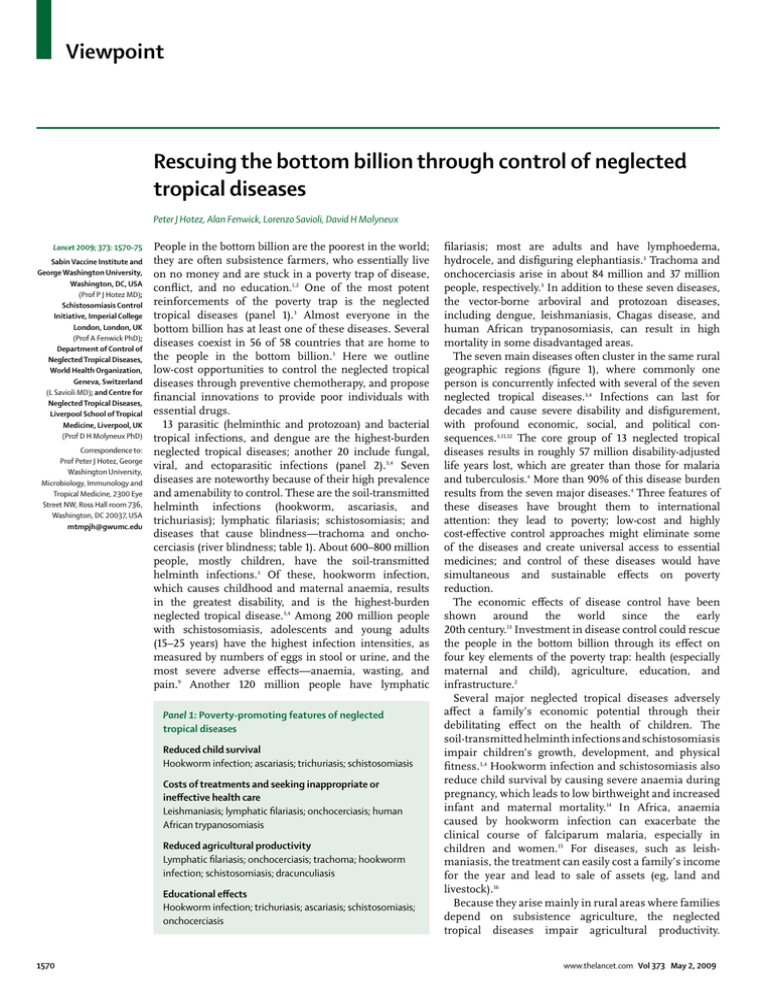
Viewpoint Rescuing the bottom billion through control of neglected tropical diseases Peter J Hotez, Alan Fenwick, Lorenzo Savioli, David H Molyneux Lancet 2009; 373: 1570–75 Sabin Vaccine Institute and George Washington University, Washington, DC, USA (Prof P J Hotez MD); Schistosomiasis Control Initiative, Imperial College London, London, UK (Prof A Fenwick PhD); Department of Control of Neglected Tropical Diseases, World Health Organization, Geneva, Switzerland (L Savioli MD); and Centre for Neglected Tropical Diseases, Liverpool School of Tropical Medicine, Liverpool, UK (Prof D H Molyneux PhD) Correspondence to: Prof Peter J Hotez, George Washington University, Microbiology, Immunology and Tropical Medicine, 2300 Eye Street NW, Ross Hall room 736, Washington, DC 20037, USA mtmpjh@gwumc.edu People in the bottom billion are the poorest in the world; they are often subsistence farmers, who essentially live on no money and are stuck in a poverty trap of disease, conflict, and no education.1,2 One of the most potent reinforcements of the poverty trap is the neglected tropical diseases (panel 1).3 Almost everyone in the bottom billion has at least one of these diseases. Several diseases coexist in 56 of 58 countries that are home to the people in the bottom billion.3 Here we outline low-cost opportunities to control the neglected tropical diseases through preventive chemotherapy, and propose financial innovations to provide poor individuals with essential drugs. 13 parasitic (helminthic and protozoan) and bacterial tropical infections, and dengue are the highest-burden neglected tropical diseases; another 20 include fungal, viral, and ectoparasitic infections (panel 2).3,4 Seven diseases are noteworthy because of their high prevalence and amenability to control. These are the soil-transmitted helminth infections (hookworm, ascariasis, and trichuriasis); lymphatic filariasis; schistosomiasis; and diseases that cause blindness—trachoma and onchocerciasis (river blindness; table 1). About 600–800 million people, mostly children, have the soil-transmitted helminth infections.3 Of these, hookworm infection, which causes childhood and maternal anaemia, results in the greatest disability, and is the highest-burden neglected tropical disease.3,4 Among 200 million people with schistosomiasis, adolescents and young adults (15–25 years) have the highest infection intensities, as measured by numbers of eggs in stool or urine, and the most severe adverse effects—anaemia, wasting, and pain.9 Another 120 million people have lymphatic Panel 1: Poverty-promoting features of neglected tropical diseases Reduced child survival Hookworm infection; ascariasis; trichuriasis; schistosomiasis Costs of treatments and seeking inappropriate or ineffective health care Leishmaniasis; lymphatic filariasis; onchocerciasis; human African trypanosomiasis Reduced agricultural productivity Lymphatic filariasis; onchocerciasis; trachoma; hookworm infection; schistosomiasis; dracunculiasis Educational effects Hookworm infection; trichuriasis; ascariasis; schistosomiasis; onchocerciasis 1570 filariasis; most are adults and have lymphoedema, hydrocele, and disfiguring elephantiasis.3 Trachoma and onchocerciasis arise in about 84 million and 37 million people, respectively.3 In addition to these seven diseases, the vector-borne arboviral and protozoan diseases, including dengue, leishmaniasis, Chagas disease, and human African trypanosomiasis, can result in high mortality in some disadvantaged areas. The seven main diseases often cluster in the same rural geographic regions (figure 1), where commonly one person is concurrently infected with several of the seven neglected tropical diseases.3,4 Infections can last for decades and cause severe disability and disfigurement, with profound economic, social, and political consequences.3,11,12 The core group of 13 neglected tropical diseases results in roughly 57 million disability-adjusted life years lost, which are greater than those for malaria and tuberculosis.4 More than 90% of this disease burden results from the seven major diseases.4 Three features of these diseases have brought them to international attention: they lead to poverty; low-cost and highly cost-effective control approaches might eliminate some of the diseases and create universal access to essential medicines; and control of these diseases would have simultaneous and sustainable effects on poverty reduction. The economic effects of disease control have been shown around the world since the early 20th century.13 Investment in disease control could rescue the people in the bottom billion through its effect on four key elements of the poverty trap: health (especially maternal and child), agriculture, education, and infrastructure.2 Several major neglected tropical diseases adversely affect a family’s economic potential through their debilitating effect on the health of children. The soil-transmitted helminth infections and schistosomiasis impair children’s growth, development, and physical fitness.3,4 Hookworm infection and schistosomiasis also reduce child survival by causing severe anaemia during pregnancy, which leads to low birthweight and increased infant and maternal mortality.14 In Africa, anaemia caused by hookworm infection can exacerbate the clinical course of falciparum malaria, especially in children and women.15 For diseases, such as leishmaniasis, the treatment can easily cost a family’s income for the year and lead to sale of assets (eg, land and livestock).16 Because they arise mainly in rural areas where families depend on subsistence agriculture, the neglected tropical diseases impair agricultural productivity. www.thelancet.com Vol 373 May 2, 2009 Viewpoint Panel 2: Neglected tropical diseases Helminth infections Ascariasis;* trichuriasis;* hookworm infection;* strongyloidiasis; toxocariasis and larva migrans; lymphatic filariasis;* onchocerciasis;* loiasis; dracunculiasis;* schistosomiasis;* food-borne trematodiases; taeniasis cysticercosis; echinococcosis Protozoan infections Leishmaniasis;* Chagas disease;* human African trypanosomiasis;* amoebiasis; giardiasis; balantidiasis Bacterial infections Bartonellosis; bovine tuberculosis; buruli ulcer;* leprosy;* leptospirosis; relapsing fever; rheumatic fever; trachoma;* treponematoses Viral infections Dengue fever; yellow fever; Japanese encephalitis; rabies; haemorrhagic fevers Fungal infections Mycetoma; paracoccidiomycosis Ectoparasitic infections Scabies; myiasis; tungiasis *13 core neglected tropical diseases. Agricultural activity is reduced directly from impaired worker productivity and hence reduced harvests, or indirectly by reduction of food security when farmers are forced to flee fertile areas because of high rates of endemic diseases. The seven main diseases have a particularly devastating effect on agricultural labour. Workers with lymphatic filariasis and chronic, irreversible lymphoedema of the lower limbs, and hydrocele have substantially reduced agricultural productivity or, in some cases, they are forced to stop working altogether.12,17 Similarly, blindness, resulting from trachoma or onchocerciasis,18,19 and anaemia, which might arise in adults because of hookworm disease and schistosomiasis,4,15 have pronounced effects on agricultural worker productivity. Furthermore, when neglected tropical diseases become pervasive, subsistence farmers are often forced to migrate, even if the new locations have poor-quality soil and climate.20 When rates of river blindness reach 10% in an agricultural community, the land is often abandoned.20 But the return of arable land from onchocerciasis control results in an economic rate of return of up to 18%.18,20 Paediatric infections with soil-transmitted helminths and schistosomes are associated with a reduction in education and school performance and attendance, and adverse effects on future earnings.13,21–24 These effects result, in part, from impairments in cognition and memory, as has been shown for chronic hookworm infection,13,22 trichuriasis,23 and schistosomiasis.24 But www.thelancet.com Vol 373 May 2, 2009 deworming programmes have shown that intervention against neglected tropical diseases in childhood is a highly cost-effective approach to improvement of education.21,25 An investment of US$3·50 per child on disease control could result in the gain of an extra school year.25 Because these diseases prevent the achievement of the first six Millennium Development Goals,3 their control with low-cost and cost-effective interventions could start long-term economic growth and development. Reduction of disease burden or interference with transmission of neglected tropical diseases through population-based chemotherapy was introduced in the 1920s. Examples of success since then include mass drug administration with diethylcarbamazine, and selective treatment or administration of diethylcarbamazine-medicated salt to interrupt the transmission of lymphatic filariasis.26 Similarly, vector control followed by mass treatment with ivermectin led to the control of onchocerciasis in ten west African countries,20 whereas azithromycin treatment and the SAFE (surgery, antibiotics, face cleanliness, and environmental improvement) strategy have eliminated trachoma that causes blindness in Morocco, Oman, and Iran, as reported to WHO,27 and multidrug treatment has eliminated leprosy as a public health problem in more than 93 countries.28 The efficacy of mass treatment was confirmed in a systematic review of randomised controlled trials.29 Because the major multinational pharmaceutical companies provide many of the drugs used for mass treatment free of charge (whereas other drugs are available as low-cost generics), this approach is one of the most cost-effective global public health control measures.3 Mass drug administration for neglected tropical diseases also provides some of the highest rates of economic return in any public health programmes, often from 15–30%, and addresses fundamental human-rights issues.3,11,28,30 Public–private partnerships working with WHO, the World Bank, and other UN agencies are providing mass drug administration to millions of people every year, leading to control and, in some cases, elimination of neglected tropical diseases.3,31 In sub-Saharan Africa, the network of more than 162 000 community-based drug distributors that provide mass treatment has strengthened health services by adding interventions such as vitamin A distribution, childhood vaccinations, and antimalarial bednets; improving national surveillance and monitoring systems; and strengthening operational research and laboratory services.3,20,28 Figure 2 shows the estimated current coverage of the main diseases with mass drug administration. Efficiency and effectiveness of mass treatment could be increased through the integration of several vertical disease control programmes.3,4,28,31 In 2005–06, a low-cost rapid effect package of four drugs—albendazole or mebendazole, and praziquantel, ivermectin or diethylcarbamazine, and azithromycin—was developed to simultaneously target the seven major neglected tropical diseases.3–5,31 For more on neglected tropical diseases see http://www.plosntds.org and http://www.globalnetwork.org 1571 Viewpoint Integration provides cost savings of almost 50%.31 To further increase efficiencies, several public–private partnerships created an alliance, the Global Network for Neglected Tropical Diseases, to begin a global campaign for integrated control in 56 countries where at least five major diseases are coendemic.3 WHO has published preventive chemotherapy guidelines for countries with the highest disease burden,5 and a Bill & Melinda Gates Disability-adjusted Deaths life years Foundation programme of implementation research will assess the public health and economic efficiencies of integration. The control of high-burden neglected tropical diseases in low-income countries will depend on sustainable, although not indefinite, external financial assistance.33 On the basis of estimates that $0·40–0·50 per person per year is needed for integrated control, about Approximate Approaches to control global prevalence High-prevalence diseases 14·9–52·1 million 24 000–415 000 Hookworm infection 1·8–22·1 million 3000–65 000 600 million Ascariasis 1·2–10·5 million 3000–60 000 800 million MDA with rapid effect package or albendazole or mebendazole Trichuriasis 1·6–6·4 million 3000–10 000 600 million MDA with rapid effect package or albendazole or mebendazole Lymphatic filariasis 5·8 million <500 120 million MDA with rapid effect package or diethylcarbamazine+albendazole or ivermectin+albendazole MDA with rapid effect package or albendazole 1·7–4·5 million Trachoma 2·3 million Onchocerciasis 0·5 million 5·0 million Dengue fever 0·7 million 19 000 50 million Integrated vector management Leishmaniasis 2·1 million 51 000 12 million Case detection and management, and integrated vector management Chagas disease 0·7 million 14 000 8–9 million Human African trypanosomiasis 1·5 million 48 000 <0·1 million <500 200 million MDA with rapid effect package Schistosomiasis Vector-borne protozoan and viral diseases 15 000–280 000 1·0–1·2 billion MDA with rapid effect package or praziquantel 84 million SAFE strategy with azithromycin <500 37 million MDA with rapid effect package or ivermectin 132 000 70 million Integrated vector management or case detection and management or both Integrated vector management Case detection and management, and tsetse control Data from Hotez and colleagues,3,4 WHO,5–7 and Bethony and colleagues.8 MDA=mass drug administration. SAFE=surgery, antibiotics, face cleanliness, and environmental improvement. Table 1: High-prevalence and other vector-borne neglected tropical diseases Five neglected tropical diseases Six neglected tropical diseases Seven neglected tropical diseases Figure 1: Map showing geographic overlap and distribution of the seven most common neglected tropical diseases Reproduced with permission from Hotez.10 1572 www.thelancet.com Vol 373 May 2, 2009 Viewpoint $2–3 billion will be needed over the next 5–7 years to effect a sustained global assault on the seven major diseases affecting the people in the bottom billion.3 This amount includes funds for monitoring, assessment, and parallel operational research, and for strengthening health systems. A long-term strategy also requires additional funds for new drugs, diagnostic materials, insecticides, and vaccines.3 Control of neglected tropical diseases remains mainly a responsibility for the public sector.33 In 2008, the UK Department for International Development committed £50 million and the US Government committed $350 million for disease control within the next 5 years. However, the US commitment must still be authorised and appropriated by the US Congress. Additional funds are needed to complete elimination efforts for guinea worm, leprosy, and other neglected tropical diseases. Global financing mechanisms for neglected tropical diseases should take into consideration several principles. First, disease-control programmes must be nationally owned, embedded in national health plans, and backed by political commitment.33 The central role of WHO and the national health ministries in the countries with endemic diseases must also be recognised, besides the work of the partners of the Global Network for Neglected Tropical Diseases, the Carter Center, and other major non-governmental development organisations, and the affected communities. Up till now, community-directed interventions, especially those done through the African Programme for Onchocerciasis Control have been highly successful, even in some fragile nations where few other health programmes exist.20 This community involvement needs to be maintained and become part of the overall health services. Improvements in health resource tracking would help monitor governance performance measures and provide better accountability for national ownership and the partners.34 An initial meeting of the global partners for neglected tropical diseases was convened by WHO in 2007, and a regular meeting must be established under the auspices of the UN.33 Even with adequate funding, there are many challenges to global disease control. Some of the most fragile countries are characterised by poor governance, authoritarian regimes, suppression of human rights, conflict, and marginalisation of particular ethnic groups; their neglected populations will continue to be denied access to essential medicines and basic services.11,28 Disenfranchised populations, including refugees, migrants, and ethnic minorities in conflict with central governments, are particularly vulnerable to these tropical diseases.3,4,11,28 Civil conflict or unrest and health service collapse are intimately related to neglected tropical diseases. A few well reported examples include lymphatic filariasis in Myanmar, leishmaniasis and Chagas disease in Colombia and Mexico, dracunculiasis in Ghana and Sudan, and onchocerciasis and human www.thelancet.com Vol 373 May 2, 2009 STH 2005 10·5% STH 2006 11·0% STH 2007 13·0% LF MDA 2005 32·4% LF MDA 2006 31·8% LF MDA 2007 41·9% Onchocerciasis* 2005 39·6% Onchocerciasis* 2006 47·7% Onchocerciasis* 2007 52·8% 0 10 20 30 40 50 60 70 80 90 100 Population at risk (%) Figure 2: Epidemiological coverage of the five major neglected tropical diseases Epidemiological coverage shown is the proportion of the population at risk in the country that has been treated with preventive chemotherapy. Population at risk is the total population living in all the endemic areas in a country and needing preventive chemotherapy. For soil-transmitted helminths (STH) target population is children aged from 1 year to 15 years. Modified from WHO.32 LF=lymphatic filariasis. MDA=mass drug administration. *Data for sub-Saharan Africa only. Total number of tablets Share of global need Sources Albendazole 3·39 billion 49% Donation by GlaxoSmithKline Mebendazole 0·25 billion 49% Donation by Johnson & Johnson as substitute for albendazole Diethylcarbamazine 4·56 billion 63% Procurement by Brazil, India, Thailand, and WHO Praziquantel 0·10 billion 5% Ivermectin 1·97 billion 100% Donation by Merck & Co Azithromycin 500 million 30% Donation by Pfizer Donation by Merck KGaA and MedPharm Reproduced with permission from WHO.35 100% albendazole is donated by GlaxoSmithKline for lymphatic filariasis programme. Table 2: Total amount of medicines for neglected tropical diseases provided by donation and direct procurement African trypanosomiasis in Angola, Democratic Republic of the Congo, and Sudan.3,11,28 More drugs, provided at no cost, are required to scale up preventive chemotherapy.33 However, multinational pharmaceutical companies that donate drugs for neglected tropical diseases might not have the capacity to scale up at the rate needed for immediate global control. Moreover, increased demand for these drugs could reduce the availability of raw materials used in manufacture.33 A WHO business plan to procure essential medicines for the expansion of preventive chemotherapy showed that less than 5% of the praziquantel estimated to be needed between 2008 and 2012 is being donated, and only half the necessary albendazole, mebendazole, and diethylcarbamazine (table 2).35 Global financing of disease control should 1573 Viewpoint take into consideration the ability of pharmaceutical manufacturers to produce the drugs at a scale commensurate with need. Funds should be earmarked for monitoring and evaluation, and for operational aspects of integration of control of neglected tropical diseases as a routine activity of national health systems at all levels. Large-scale drug distribution for the seven major diseases has the risk of drug resistance, just as it does for malaria, tuberculosis, and HIV/AIDS.3 The possibility of resistance must be anticipated; therefore global financing mechanisms should take into consideration investments for new anthelminthic drugs and vaccines, especially for hookworm infection and other neglected tropical diseases.3,4 Additional support must be considered for the control (including case detection and management, and intensified vector management) of the selected vectorborne diseases other than the seven major neglected tropical diseases (table 1). Global financing for neglected tropical diseases should also support research and development for new diagnostic agents, drugs, insecticides, and vaccines. Over the next few years the funds so far committed by the G8 nations will probably represent only a small fraction of those needed for the global control of the seven major diseases. No other major commitments exist for the control of other important vector-borne neglected tropical diseases or for research. Global financing for these diseases must be created to encourage additional private investments like those secured by the Global Network for Neglected Tropical Diseases and non-governmental development organisations. New and catalytic funding by the Bill & Melinda Gates Foundation in 2009 is expected to leverage investments in disease control and to help harmonise existing partnerships. The Global Philanthropy Forum, Clinton Global Initiative, and World Economic Forum are possible venues to link donors with the neglectedtropical-disease partnerships and WHO, procure essential medicines, and expand preventive chemotherapy. An important goal would be to reach 100% coverage in endemic countries with high-quality medicines free of charge by 2012.33 Control efforts have largely been focused on Africa. However, fund allocation must optimise flexibility, because control of neglected tropical diseases in Latin America, Asia, and the Middle East have ecologies, infections, and health systems that differ from the mechanisms delineated for Africa. We live in an almost $100 trillion economy;2 therefore $2–3 billion committed as innovative, flexible, responsive, transparent, and accountable funds for comprehensive disease control should be considered a modest yet highly cost-effective mechanism for alleviating the poverty of people in the bottom billion. Such low costs and efficiencies will be especially welcomed in these new times of economic difficulties. 1574 With the track record of high return rates on investments in neglected tropical diseases,28 and recognition that these diseases represent an important challenge to global security11 and fundamental human rights,3 this amount is especially small and will address a major development problem and bring hope to the most disenfranchised populations. Contributors PJH, AF, LS, and DM contributed to the writing of the paper and to subsequent revisions. Conflicts of interest PJH, AF, LS, and DM are cofounders of the Global Network for Neglected Tropical Diseases. Acknowledgments We thank Regina Rabinovich and Julie Jacobson from the Bill & Melinda Gates Foundation, and Kari Stoever from Sabin Vaccine Institute for their suggestions after reviewing early drafts of the report. References 1 Collier P. The bottom billion: why the poorest countries are failing and what can be done about it. Oxford: Oxford University Press, 2007: 3–13. 2 Sachs JD. Common wealth: economics for a crowded planet. New York: The Penguin Press, 2008: 386. 3 Hotez PJ, Molyneux DH, Fenwick A, et al. Control of neglected tropical diseases. N Engl J Med 2007; 357: 1018–27. 4 Hotez PJ, Molyneux DH, Fenwick A, Ottesen E, Ehrlich Sachs S, Sachs JD. Incorporating a rapid-impact package for neglected tropical diseases with programs for HIV/AIDS, tuberculosis, and malaria. PLoS Med 2006; 3: e102. 5 WHO. Preventive chemotherapy in human helminthiasis. Coordinated use of anthelminthic drugs in control interventions: a manual for health professionals and programme managers. Geneva: World Health Organization, 2006. 6 WHO. Deaths by cause, sex and mortality stratum in WHO Regions, estimates for 2002. Geneva: World Health Organization, 2004. http://www.who.int/whr/2004/annex/topic/annex2.xls (accessed Jan 7, 2009). 7 WHO. Burden of disease in DALYs by cause, sex and mortality stratum in WHO regions, estimates for 2002. Geneva: World Health Organization, 2004. http://www.who.int/whr/2004/annex/topic/ annex3.xls (accessed Jan 7, 2009). 8 Bethony J, Brooker S, Albonico M, et al. Soil-transmitted helminth infections: ascariasis, trichuriasis and hookworm. Lancet 2006; 367: 1521–32. 9 King CH, Dickman K, Tisch DJ. Reassessment of the cost of chronic helminthic infection: a meta-analysis of disability-related outcomes in endemic schistosomiasis. Lancet 2005; 365: 1561–69. 10 Hotez PJ. Forgotten people, forgotten diseases: the neglected tropical diseases and their impact on global health and development. Washington, DC: ASM Press, 2008; 215. 11 Beyrer C, Villar JC, Suwanvanichkij V, Singh S, Baral SD, Mills EJ. Health and human rights 3: neglected diseases, civil conflicts, and the right to health. Lancet 2007; 370: 619–27. 12 Perera M, Whitehead M, Molyneux D, Weerasooriya M, Gunatilleke G. Neglected patients in neglected disease? A qualitative study of lymphatic filariasis. PLoS Negl Trop Dis 2007; 1: e128. 13 Bleakley H. Disease and development: evidence from hookworm eradication in the American South. Q J Econ 2007; 122: 73–117. 14 Brooker S, Hotez PJ, Bundy DA. Hookworm-related anaemia among pregnant women: a systematic review. PLoS Negl Trop Dis 2008; 2: e291. 15 Brooker S, Akhwale W, Pullan R, et al. Epidemiology of Plasmodium-helminth co-infection in Africa: population at risk, potential impact on anemia, and prospects for combining control. Am J Trop Med Hyg 2007; 77 (suppl 6): 88–98. 16 Adhikari SR, Maskay NM. The economic burden of kala-azar in households of the Danusha and Mahottari districts of Nepal. Acta Trop 2003; 88: 1–2. www.thelancet.com Vol 373 May 2, 2009 Viewpoint 17 18 19 20 21 22 23 24 25 26 Ramaiah KD, Radhamani MP, John KR, et al. The impact of lymphatic filariasis on labour inputs in southern India: results of a multi-site study. Ann Trop Med Parasitol 2000; 94: 353–63. Benton B. Economic impact of onchocerciasis control through the African Programme for Onchocerciasis Control: an overview. Ann Trop Med Parasitol 1998; 92 (suppl 1): S33–39. Frick KD, Hanson CL, Jacobson GA. Global burden of trachoma and economics of disease. Am J Trop Med Hyg 2003; 69 (5 suppl): 1–10. Amazigo U, Noma M, Bump J, et al. Onchocerciasis (chapter 15). In: Jamison DT, Feachem RG, Makgoba MW, eds. Disease and mortality in sub-Saharan Africa, 2nd edn. Washington, DC: World Bank, 2006: 215–22. Miguel EA, Kremer M. Worms: identifying impacts on education and health in the presence of treatment externalities. Econometrica 2004; 72: 159–217. Sakti H, Nokes C, Hertanto WS, et al. Evidence for an association between hookworm infection and cognitive function in Indonesia school children. Trop Med Int Health 1999; 4: 322–34. Nokes C, Grantham-McGregor SM, Sawyer AW, Cooper ES, Robinson BA, Bundy DA. Moderate to heavy infections of Trichuris trichiura affect cognitive function in Jamaican school children. Parasitology 1992; 104: 539–47. Jukes MC, Nokes CA, Alcock KJ, et al. Partnership for child development. Heavy schistosomiasis associated with poor short-term memory and slower reaction times in Tanzanian schoolchildren. Trop Med Int Health 2002; 7: 104–17. The Lancet. Thinking beyond deworming. Lancet 2004; 364: 1993–94. Ichimori K, Graves PM, Crump A. Lymphatic filariasis elimination in the Pacific: PacELF replicating Japanese success. Trends Parasitol 2007; 23: 36–40. www.thelancet.com Vol 373 May 2, 2009 27 28 29 30 31 32 33 34 35 Cook JA. Eliminating blinding trachoma. N Engl J Med 2008; 358: 1777–79. Molyneux DH. Combating the “other diseases” of MDG 6: changing the paradigm to achieve equity and poverty reduction? Trans R Soc Trop Med Hyg 2008; 102: 509–19. Reddy M, Gill SS, Kalkar SR, Anderson PJ, Rochon PA. Oral drug therapy for multiple neglected tropical diseases: a systematic review. JAMA 2007; 298: 1911–24. Molyneux DH. “Neglected” diseases but unrecognized successes—challenges and opportunities for infectious disease control. Lancet 2004; 364: 380–83. Brady MA, Hooper PJ, Ottesen EA. Projected benefits from integrating NTD programs in sub-Saharan Africa. Trends Parasitol 2006; 22: 285–91. WHO. Preventive chemotherapy databank, January 2009. Geneva: World Health Organization. http://www.who.int/neglected_ diseases/preventive_chemotherapy/databank/en/ (accessed March 5, 2009). WHO/Carter Center. Integrated control of the neglected tropical diseases: a neglected opportunity ripe for action. Paper jointly prepared by WHO and the Carter Center presented to the Global Health and the United Nations meeting, May 8, 2008. Geneva/Atlanta; World Health Organization/Carter Center. http://www.who.int/neglected_diseases/NTD_integrated_control. pdf (accessed June 21, 2008). Powell-Jackson T, Mills A. A review of health resource tracking in developing countries. Health Policy Plan 2007; 22: 353–62. WHO. Procurement of essential medicines for expanding preventive chemotherapy for neglected tropical diseases, March 2008. Geneva: World Health Organization, 2008. 1575

